
Bitcoin Investing for Beginners: What Can You Do Besides Just Buying?
Since Bitcoin’s inception in 2009, it has experienced a remarkable rise, growing from mere cents to exceeding $100,000 per unit by December 2024, setting a new historical high. This surge not only reflects Bitcoin's growing acceptance as a digital currency but also highlights its unique role in the global financial landscape. For investors, Bitcoin's performance has proven its potential as a valuable asset. Notably, in January 2024, the U.S. Securities and Exchange Commission (SEC) approved 11 Bitcoin spot ETFs, sparking significant market enthusiasm and driving Bitcoin's price even higher. The launch of these ETFs has opened new doors for both retail and institutional investors to gain exposure to Bitcoin, enhancing liquidity and market depth. If you're interested in getting started with Bitcoin, there are more options than just purchasing the cryptocurrency. This article will guide you through not only acquiring your first Bitcoin but also exploring other ways to invest in and analyze Bitcoin, helping you understand the key metrics that influence its value.
Step 1: Understanding Bitcoin on SoSoValue
Bitcoin (BTC) is a decentralized digital currency, pivotal in shaping the financial landscape since its inception. At Soso Value, we provide an in-depth explanation of Bitcoin's fundamental mechanisms and historical significance:
Core Mechanism:
Bitcoin transactions are verified by network nodes through cryptography and recorded in a publicly accessible distributed ledger known as a blockchain. This verification and recording process, often referred to as mining, occurs every 10 minutes. The miner who successfully discovers the new block is rewarded by the network with all the transaction fees from the transactions they have included in the block, as well as a predetermined amount of newly created bitcoins.
Historical Context:
Bitcoin was conceptualized in 2008 by an enigmatic figure or group known as Satoshi Nakamoto. The actual usage of Bitcoin began in 2009 with the release of its implementation as open-source software. The genesis of Bitcoin was marked by the publication of a white paper on October 31, 2008, which can be found here.
Global Stance and Adoption:
As reported by the Library of Congress, as of November 2021, Bitcoin usage is fully banned in nine countries, with an additional forty-two countries having implicit restrictions. Despite these restrictions, some governments have adopted Bitcoin for strategic purposes. For instance, El Salvador has recognized Bitcoin as legal tender, though its widespread use among merchants is limited. Ukraine has accepted cryptocurrency donations to support its resistance against the Russian invasion in 2022, and Iran has utilized Bitcoin to circumvent sanctions.
Innovations and Developments:
Lightning Network: A significant advancement in Bitcoin's ecosystem is the Lightning Network (LN), a "layer 2" payment protocol designed to enable quick transactions between nodes. It addresses Bitcoin's scalability challenges and supports micropayments through a network of bidirectional payment channels without necessitating the custody of funds.
Bitcoin Ordinals: Introduced prominently in April 2023, Bitcoin Ordinals are digital assets inscribed directly onto a satoshi, the smallest unit of Bitcoin. enabled by the Taproot upgrade activated on November 14, 2021, Ordinals function similarly to Non-Fungible Tokens (NFTs), allowing the inscription of diverse content types such as images, videos, and games onto the Bitcoin blockchain.
For comprehensive understanding and real-time data on Bitcoin, including detailed analytics and observation indicators, visit our dedicated Bitcoin dashboard at SoSoValue.
Step 2: Understanding Bitcoin through Inflation Machenism
Bitcoin's supply is inherently different from that of fiat currencies like the U.S. Dollar (USD), and understanding this distinction is crucial for assessing Bitcoin's value proposition.
Bitcoin's Inflation Mechanism:
Bitcoin has a fixed supply cap of 21 million coins, which gives it a unique advantage in terms of scarcity. Unlike traditional currencies, Bitcoin’s supply is not subject to manipulation by central banks. Additionally, Bitcoin undergoes a halving event approximately every four years, reducing the number of new bitcoins created and entering circulation. As a result, the annual inflation rate of Bitcoin declines over time, reaching an estimated 1.8% in 2024. This inflation rate will continue to decrease as the total supply approaches its hard cap of 21 million.
USD's Inflation Mechanism:
In contrast, the inflation rate of the USD is controlled by the Federal Reserve and influenced by economic factors such as monetary policy, interest rates, and fiscal policies. The supply of USD is dynamic, with central banks able to increase the money supply through mechanisms like quantitative easing. Over time, this has led to the devaluation of the dollar, as seen with inflation spikes during periods of economic stimulus, such as the COVID-19 pandemic, when inflation surged above 5% in 2021 and 2022.
Key Comparisons:
Supply Control: Bitcoin’s supply is fixed and predictable, leading to a decreasing inflation rate, while the USD's supply is manipulated by policy decisions, which can result in volatility in its inflation rate.
Scarcity: Bitcoin’s inherent scarcity makes it a potential hedge against inflation, as its purchasing power can increase as fiat currencies devalue. On the other hand, USD’s inflation rate can erode its purchasing power over time.
Market Impact: While Bitcoin’s inflation rate is steady and well-understood, the USD’s inflation can fluctuate significantly based on economic policies and external factors.
By understanding these differences, investors can better assess Bitcoin’s potential as a store of value, particularly in environments where traditional fiat currencies are experiencing high inflation.
Step 3: Explore Bitcoin ETFs on SoSoValue
In the rapidly evolving cryptocurrency landscape, the United States currently boasts 11 Bitcoin ETFs, which are crucial financial tools for both retail and institutional investors. These ETFs provide a simplified method to gain exposure to Bitcoin, without the complexities and risks associated with direct ownership. Effectively utilizing this investment avenue requires vigilant monitoring of these ETFs' fund inflows and outflows, as well as their trading volumes.
At SoSoValue, we offer real-time data and analytics on these indicators, which are indispensable for assessing investor sentiment and market trends. This includes:
Daily and Cumulative Net Inflows: By monitoring the daily and cumulative net inflows of Bitcoin ETFs, investors can quickly grasp market capital movements. For instance, as of December 10, 2024, Soso Value recorded a daily net inflow of $439.56M and a cumulative total net inflow of $34.35B. These data points provide crucial insights into market participation and capital trends.
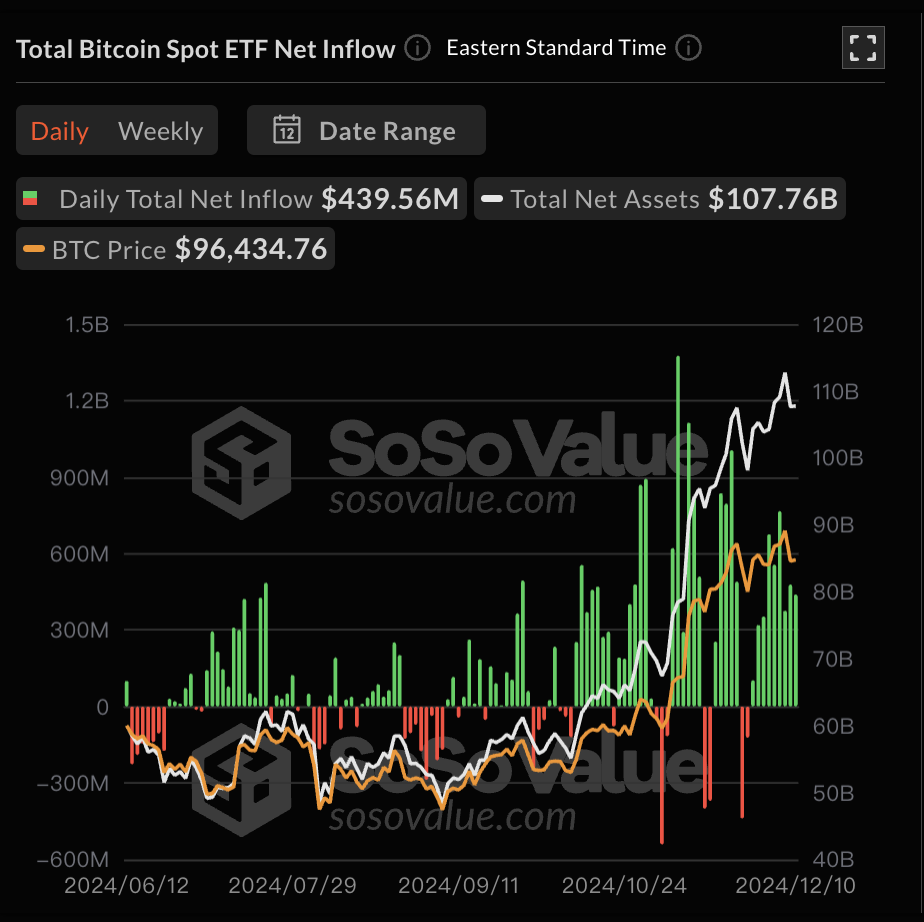
Total Value Traded and Total Net Assets: Additionally, Soso Value provides detailed information about the total value traded and the net assets of ETFs. On the same day, the total value traded reached $3.78B, with total net assets amounting to $107.76B. These figures not only display the market size of Bitcoin ETFs but also reflect the confidence investors place in Bitcoin ETFs and the level of activity in the market.
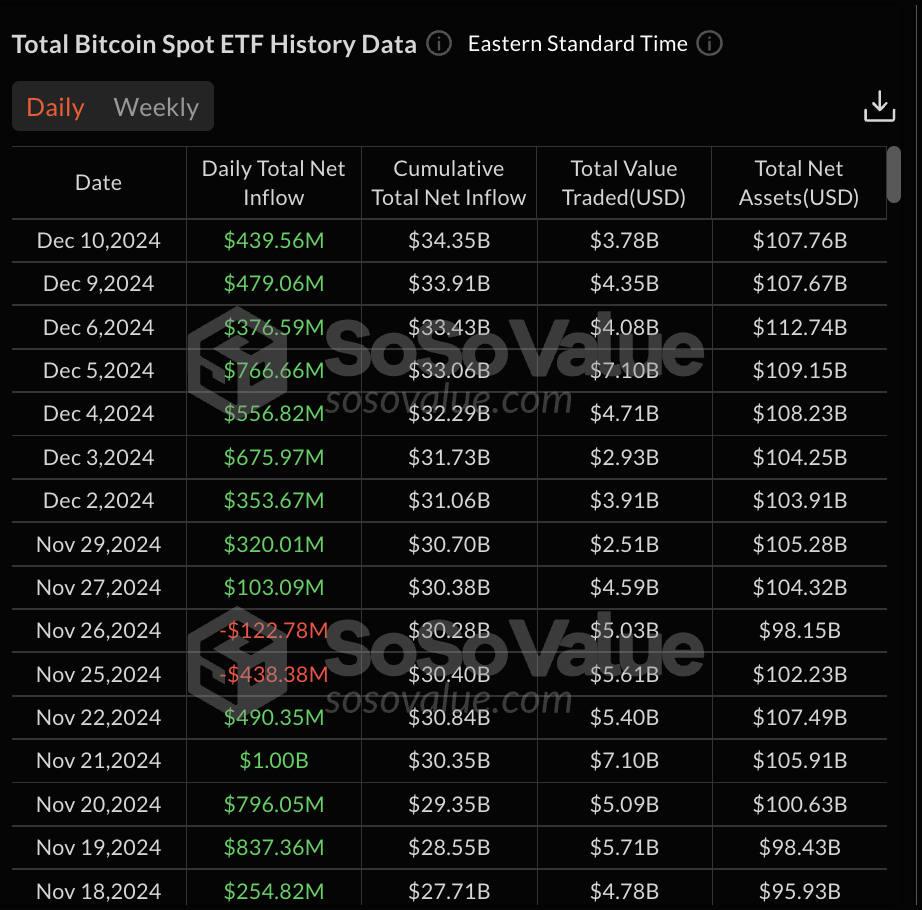
Market Prices and Trading Volumes: The market price and trading volume of each Bitcoin ETF are also essential factors in investment decisions. For example, the Grayscale Bitcoin Trust (GBTC) had a market price of $80.34 and a trading volume of 1.78M shares on that day. These metrics help investors evaluate the liquidity and market acceptance of each ETF.
Comprehensive Dashboard: Soso Value's Bitcoin ETF comprehensive dashboard provides an interactive view, aggregating key data for all Bitcoin ETFs. From daily price changes to long-term trends, investors can easily navigate and delve into analyses to support smarter investment decisions.

News and Market Dynamics: Keeping abreast of relevant news is also essential. Soso Value's platform is regularly updated with the latest news and market developments related to Bitcoin ETFs, helping investors stay informed about factors that affect the market.
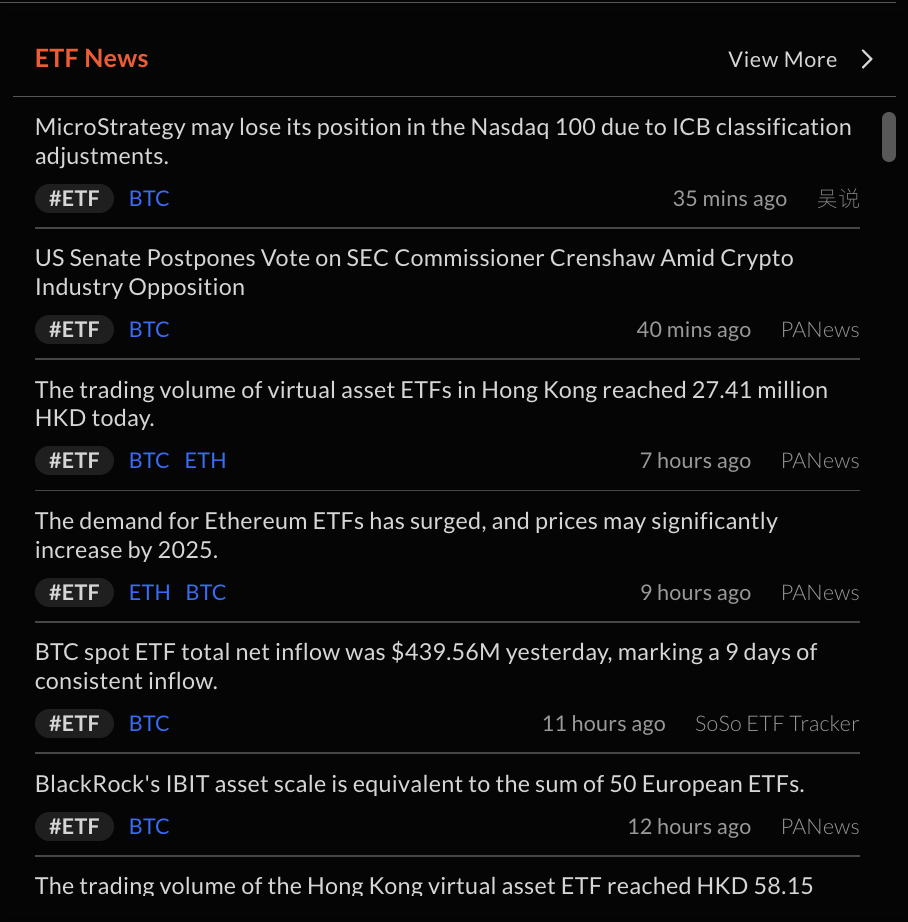
Through the in-depth analysis and data-driven insights provided by SoSoValue, investors can more effectively master the market dynamics of Bitcoin ETFs, optimizing their investment portfolios. Visit SoSoValue to explore more professional analyses and real-time data about Bitcoin and its related financial products.
Step 4: Choose a Reliable Crypto Exchange
Selecting the right cryptocurrency exchange is critical for your investment success. Factors like security, user experience, and transaction fees play a significant role in this decision. At SoSoValue, we understand the importance of making informed choices and provide detailed data on various exchanges to aid your decision-making process.
Detailed Exchange Comparisons on SoSoValue On the Bitcoin detail page of SoSoValue, investors can find comprehensive information on multiple Centralized Exchanges (CEX). We offer real-time data for various trading pairs, including the current prices, daily trading volumes, and their market share percentages. This extensive data allows investors to assess liquidity and identify potential arbitrage opportunities efficiently.
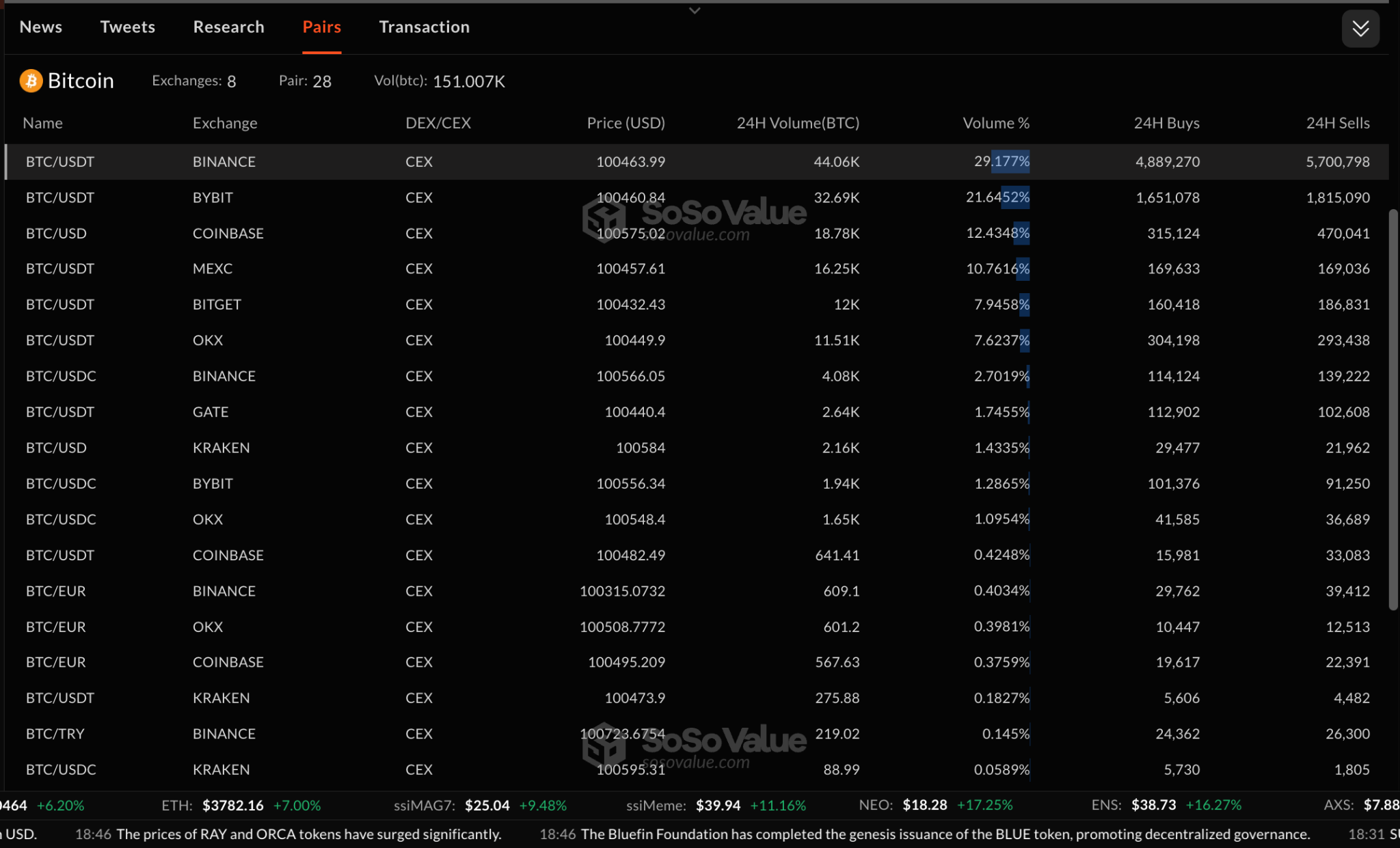
Why Choose SoSoValue for Exchange Information?
Real-Time Price Updates: Stay updated with the most recent prices for a variety of Bitcoin trading pairs across different exchanges.
Volume and Market Share Insights: Understand which exchanges have the highest trading volumes and market shares, which can indicate liquidity and popularity among traders.
Arbitrage Opportunities: Easily spot price discrepancies between exchanges for potential arbitrage opportunities, enabling you to make profitable trades.
By leveraging the detailed analytics provided on SosoValue’s Bitcoin detail page, investors can make more precise and strategic decisions when selecting a cryptocurrency exchange that best fits their investment needs. Visit SoSoValue to explore our in-depth reviews and up-to-date market data, ensuring you choose the most suitable and reliable platform for your crypto trading activities
Step 5: Monitor Bitcoin Indicators with Soso Value's Comprehensive Dashboard
Making informed, data-driven decisions is crucial in the cryptocurrency space. SosoValue offers a robust suite of analytical tools that allow investors to delve deeply into the market dynamics of Bitcoin. These tools cover everything from price fluctuations to transaction activities, providing detailed insights from both on-chain and off-chain sources.
Detailed Insights from SoSoValue’s Bitcoin Dashboard:
On-Chain Data Monitoring:
Active and New Addresses: Tracks the number of active and newly created Bitcoin wallet addresses, providing insights into network participation and growth trends.
Mining Difficulty and Block Rewards: Analyzes changes in mining difficulty and block rewards, offering a view into the computational effort and new Bitcoin entering circulation.
Off-Chain Transaction Analysis:
Funding Rates and Futures Open Interest: Observes funding rates and open interest across major exchanges like Binance and CME, helping assess market sentiment and potential price movements.
Bitcoin Futures Volume: Monitors the volume of Bitcoin futures traded, indicating market activity levels and potential upcoming volatility.
Market Analysis Tools:
Trading Volume and Market Price Trends: Monitors trading volumes and price changes over various time frames to gauge market activity and investor interest.
Market Depth and Liquidity Analysis: Compares liquidity and market depth across different exchanges and trading pairs to identify the best trading opportunities.
Additional Key Indicators:
Bitcoin Spot ETF Net Inflow: Reflects the total money flow into Bitcoin spot ETFs, suggesting investor confidence and potential market moves.
Long/Short Ratio: Shows the ratio of long to short positions in BTCUSDT futures, providing insights into market bullishness or bearishness.
Bitcoin Transaction Types Distribution: Displays the diversity in Bitcoin transaction types, enriching understanding of network utility and engagement.
Bitcoin Hashrate and Mining Difficulty: Measures network computational power and mining challenge, important for assessing network security and miner commitment.
Miner Revenue: Tracks total Bitcoin earned by miners, indicating network health and economic viability.
Real-Time Market News and Updates:
Stay informed with the latest news and developments affecting the Bitcoin space with timely updates directly from Soso Value, ensuring you have all the necessary information to impact your trading decisions effectively.
By accessing SoSoValue's Bitcoin Dashboard, investors can leverage advanced analytics to understand market dynamics comprehensively. Our tools are designed to provide both novice and experienced investors with the data they need to effectively navigate the complexities of the Bitcoin market, supporting smarter investment decisions through a deep, data-driven understanding of the market.
Conclusion
Embarking on your Bitcoin investing journey requires a solid understanding of its core concepts and access to accurate, real-time data. At SoSo Value, we empower you with the essential tools and insights to make informed, confident investment decisions. Our platform offers detailed market analyses, up-to-the-minute price updates, and comprehensive dashboards, ensuring you're equipped to navigate the complexities of cryptocurrency investments. Whether you're new to Bitcoin or looking to refine your investment strategy, SoSo Value provides the data-driven support you need. Start your investment journey today and explore our Bitcoin dashboard—let SoSo Value guides you towards smarter, more strategic investment choices.

Bitcoin Investing for Beginners: What Can You Do Besides Just Buying?
Since Bitcoin’s inception in 2009, it has experienced a remarkable rise, growing from mere cents to exceeding $100,000 per unit by December 2024, setting a new historical high. This surge not only reflects Bitcoin's growing acceptance as a digital currency but also highlights its unique role in the global financial landscape. For investors, Bitcoin's performance has proven its potential as a valuable asset. Notably, in January 2024, the U.S. Securities and Exchange Commission (SEC) approved 11 Bitcoin spot ETFs, sparking significant market enthusiasm and driving Bitcoin's price even higher. The launch of these ETFs has opened new doors for both retail and institutional investors to gain exposure to Bitcoin, enhancing liquidity and market depth. If you're interested in getting started with Bitcoin, there are more options than just purchasing the cryptocurrency. This article will guide you through not only acquiring your first Bitcoin but also exploring other ways to invest in and analyze Bitcoin, helping you understand the key metrics that influence its value.
Step 1: Understanding Bitcoin on SoSoValue
Bitcoin (BTC) is a decentralized digital currency, pivotal in shaping the financial landscape since its inception. At Soso Value, we provide an in-depth explanation of Bitcoin's fundamental mechanisms and historical significance:
Core Mechanism:
Bitcoin transactions are verified by network nodes through cryptography and recorded in a publicly accessible distributed ledger known as a blockchain. This verification and recording process, often referred to as mining, occurs every 10 minutes. The miner who successfully discovers the new block is rewarded by the network with all the transaction fees from the transactions they have included in the block, as well as a predetermined amount of newly created bitcoins.
Historical Context:
Bitcoin was conceptualized in 2008 by an enigmatic figure or group known as Satoshi Nakamoto. The actual usage of Bitcoin began in 2009 with the release of its implementation as open-source software. The genesis of Bitcoin was marked by the publication of a white paper on October 31, 2008, which can be found here.
Global Stance and Adoption:
As reported by the Library of Congress, as of November 2021, Bitcoin usage is fully banned in nine countries, with an additional forty-two countries having implicit restrictions. Despite these restrictions, some governments have adopted Bitcoin for strategic purposes. For instance, El Salvador has recognized Bitcoin as legal tender, though its widespread use among merchants is limited. Ukraine has accepted cryptocurrency donations to support its resistance against the Russian invasion in 2022, and Iran has utilized Bitcoin to circumvent sanctions.
Innovations and Developments:
Lightning Network: A significant advancement in Bitcoin's ecosystem is the Lightning Network (LN), a "layer 2" payment protocol designed to enable quick transactions between nodes. It addresses Bitcoin's scalability challenges and supports micropayments through a network of bidirectional payment channels without necessitating the custody of funds.
Bitcoin Ordinals: Introduced prominently in April 2023, Bitcoin Ordinals are digital assets inscribed directly onto a satoshi, the smallest unit of Bitcoin. enabled by the Taproot upgrade activated on November 14, 2021, Ordinals function similarly to Non-Fungible Tokens (NFTs), allowing the inscription of diverse content types such as images, videos, and games onto the Bitcoin blockchain.
For comprehensive understanding and real-time data on Bitcoin, including detailed analytics and observation indicators, visit our dedicated Bitcoin dashboard at SoSoValue.
Step 2: Understanding Bitcoin through Inflation Machenism
Bitcoin's supply is inherently different from that of fiat currencies like the U.S. Dollar (USD), and understanding this distinction is crucial for assessing Bitcoin's value proposition.
Bitcoin's Inflation Mechanism:
Bitcoin has a fixed supply cap of 21 million coins, which gives it a unique advantage in terms of scarcity. Unlike traditional currencies, Bitcoin’s supply is not subject to manipulation by central banks. Additionally, Bitcoin undergoes a halving event approximately every four years, reducing the number of new bitcoins created and entering circulation. As a result, the annual inflation rate of Bitcoin declines over time, reaching an estimated 1.8% in 2024. This inflation rate will continue to decrease as the total supply approaches its hard cap of 21 million.
USD's Inflation Mechanism:
In contrast, the inflation rate of the USD is controlled by the Federal Reserve and influenced by economic factors such as monetary policy, interest rates, and fiscal policies. The supply of USD is dynamic, with central banks able to increase the money supply through mechanisms like quantitative easing. Over time, this has led to the devaluation of the dollar, as seen with inflation spikes during periods of economic stimulus, such as the COVID-19 pandemic, when inflation surged above 5% in 2021 and 2022.
Key Comparisons:
Supply Control: Bitcoin’s supply is fixed and predictable, leading to a decreasing inflation rate, while the USD's supply is manipulated by policy decisions, which can result in volatility in its inflation rate.
Scarcity: Bitcoin’s inherent scarcity makes it a potential hedge against inflation, as its purchasing power can increase as fiat currencies devalue. On the other hand, USD’s inflation rate can erode its purchasing power over time.
Market Impact: While Bitcoin’s inflation rate is steady and well-understood, the USD’s inflation can fluctuate significantly based on economic policies and external factors.
By understanding these differences, investors can better assess Bitcoin’s potential as a store of value, particularly in environments where traditional fiat currencies are experiencing high inflation.
Step 3: Explore Bitcoin ETFs on SoSoValue
In the rapidly evolving cryptocurrency landscape, the United States currently boasts 11 Bitcoin ETFs, which are crucial financial tools for both retail and institutional investors. These ETFs provide a simplified method to gain exposure to Bitcoin, without the complexities and risks associated with direct ownership. Effectively utilizing this investment avenue requires vigilant monitoring of these ETFs' fund inflows and outflows, as well as their trading volumes.
At SoSoValue, we offer real-time data and analytics on these indicators, which are indispensable for assessing investor sentiment and market trends. This includes:
Daily and Cumulative Net Inflows: By monitoring the daily and cumulative net inflows of Bitcoin ETFs, investors can quickly grasp market capital movements. For instance, as of December 10, 2024, Soso Value recorded a daily net inflow of $439.56M and a cumulative total net inflow of $34.35B. These data points provide crucial insights into market participation and capital trends.
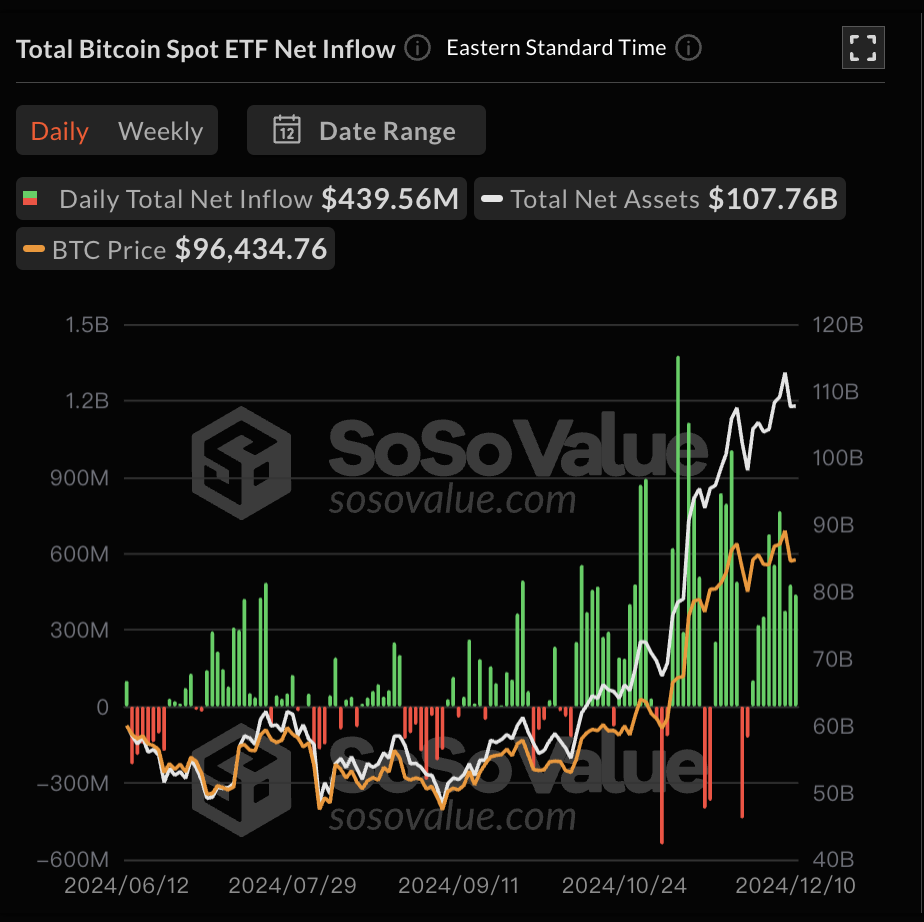
Total Value Traded and Total Net Assets: Additionally, Soso Value provides detailed information about the total value traded and the net assets of ETFs. On the same day, the total value traded reached $3.78B, with total net assets amounting to $107.76B. These figures not only display the market size of Bitcoin ETFs but also reflect the confidence investors place in Bitcoin ETFs and the level of activity in the market.
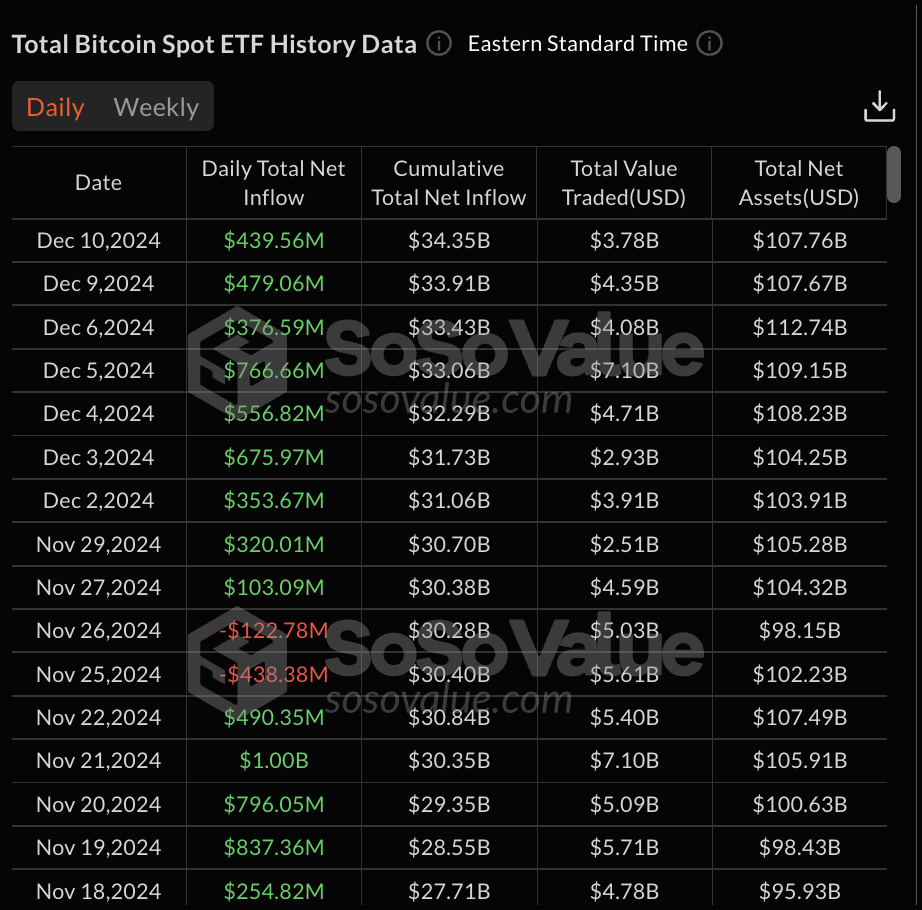
Market Prices and Trading Volumes: The market price and trading volume of each Bitcoin ETF are also essential factors in investment decisions. For example, the Grayscale Bitcoin Trust (GBTC) had a market price of $80.34 and a trading volume of 1.78M shares on that day. These metrics help investors evaluate the liquidity and market acceptance of each ETF.
Comprehensive Dashboard: Soso Value's Bitcoin ETF comprehensive dashboard provides an interactive view, aggregating key data for all Bitcoin ETFs. From daily price changes to long-term trends, investors can easily navigate and delve into analyses to support smarter investment decisions.

News and Market Dynamics: Keeping abreast of relevant news is also essential. Soso Value's platform is regularly updated with the latest news and market developments related to Bitcoin ETFs, helping investors stay informed about factors that affect the market.
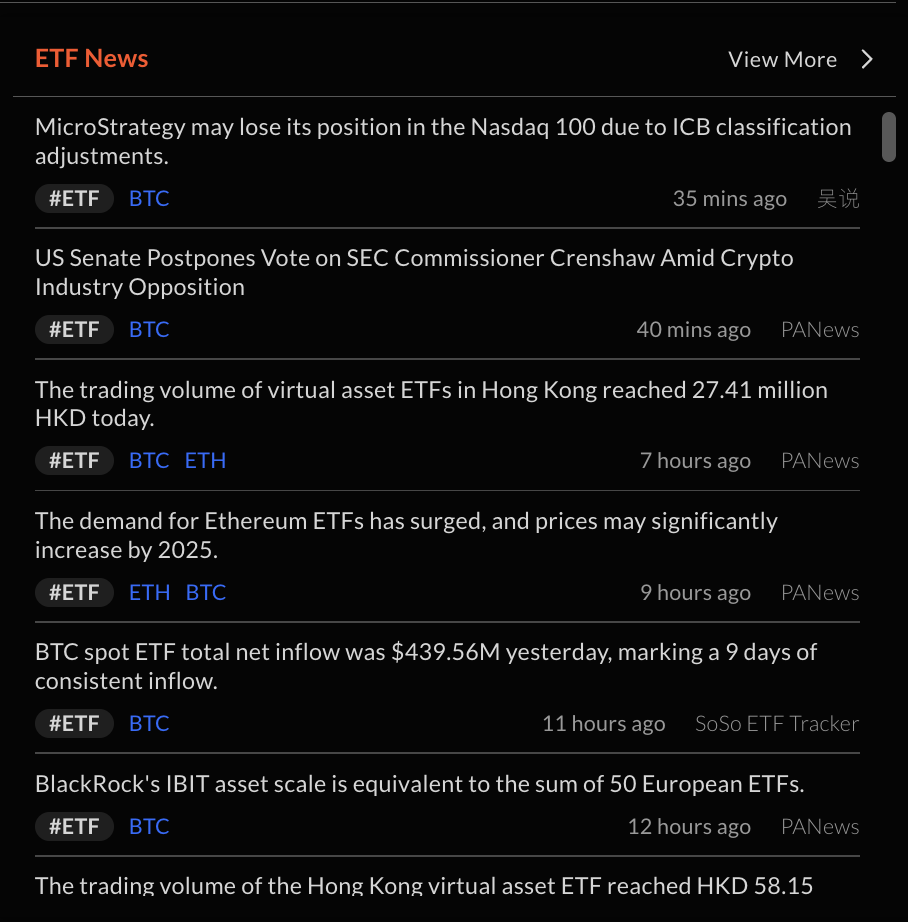
Through the in-depth analysis and data-driven insights provided by SoSoValue, investors can more effectively master the market dynamics of Bitcoin ETFs, optimizing their investment portfolios. Visit SoSoValue to explore more professional analyses and real-time data about Bitcoin and its related financial products.
Step 4: Choose a Reliable Crypto Exchange
Selecting the right cryptocurrency exchange is critical for your investment success. Factors like security, user experience, and transaction fees play a significant role in this decision. At SoSoValue, we understand the importance of making informed choices and provide detailed data on various exchanges to aid your decision-making process.
Detailed Exchange Comparisons on SoSoValue On the Bitcoin detail page of SoSoValue, investors can find comprehensive information on multiple Centralized Exchanges (CEX). We offer real-time data for various trading pairs, including the current prices, daily trading volumes, and their market share percentages. This extensive data allows investors to assess liquidity and identify potential arbitrage opportunities efficiently.
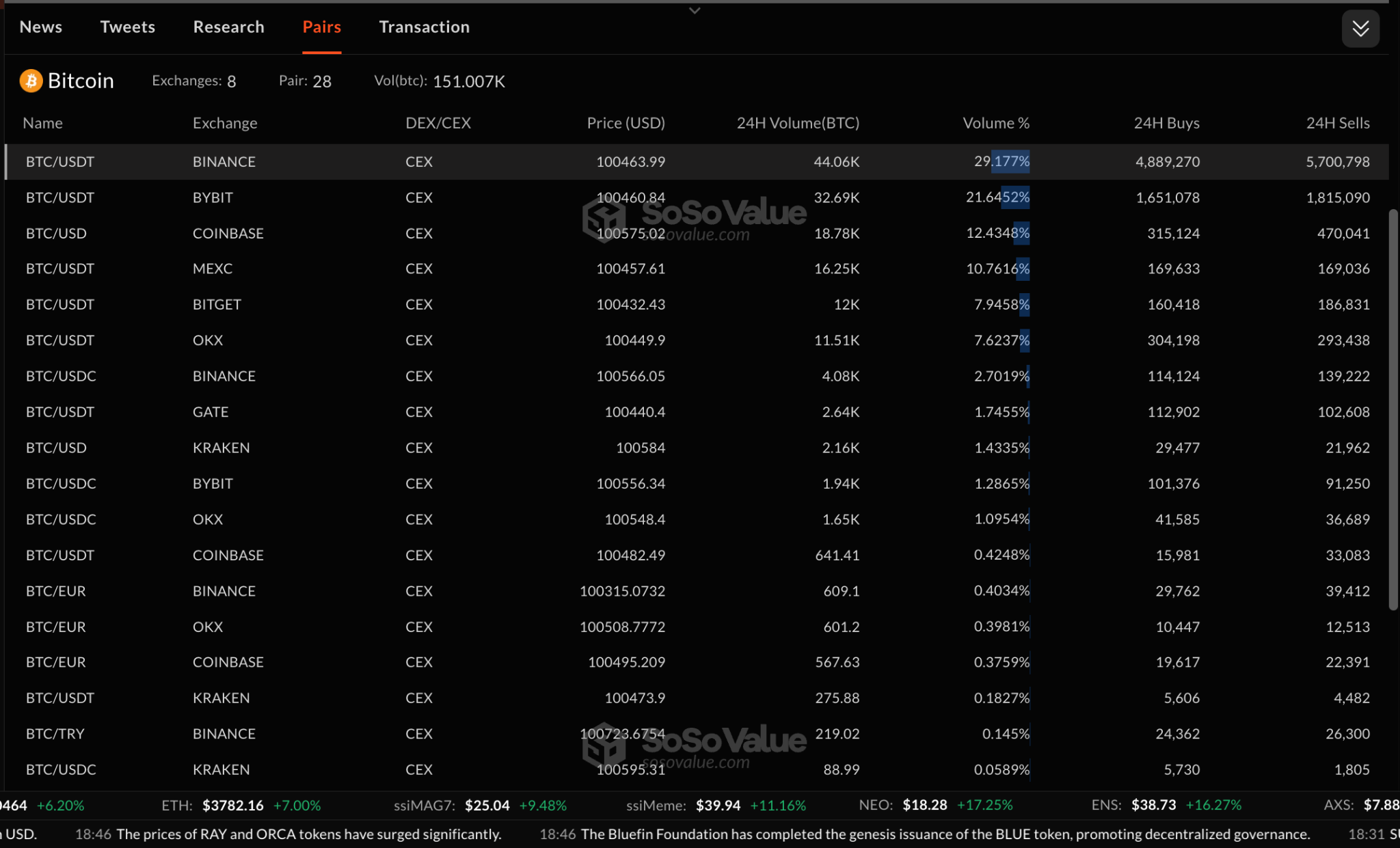
Why Choose SoSoValue for Exchange Information?
Real-Time Price Updates: Stay updated with the most recent prices for a variety of Bitcoin trading pairs across different exchanges.
Volume and Market Share Insights: Understand which exchanges have the highest trading volumes and market shares, which can indicate liquidity and popularity among traders.
Arbitrage Opportunities: Easily spot price discrepancies between exchanges for potential arbitrage opportunities, enabling you to make profitable trades.
By leveraging the detailed analytics provided on SosoValue’s Bitcoin detail page, investors can make more precise and strategic decisions when selecting a cryptocurrency exchange that best fits their investment needs. Visit SoSoValue to explore our in-depth reviews and up-to-date market data, ensuring you choose the most suitable and reliable platform for your crypto trading activities
Step 5: Monitor Bitcoin Indicators with Soso Value's Comprehensive Dashboard
Making informed, data-driven decisions is crucial in the cryptocurrency space. SosoValue offers a robust suite of analytical tools that allow investors to delve deeply into the market dynamics of Bitcoin. These tools cover everything from price fluctuations to transaction activities, providing detailed insights from both on-chain and off-chain sources.
Detailed Insights from SoSoValue’s Bitcoin Dashboard:
On-Chain Data Monitoring:
Active and New Addresses: Tracks the number of active and newly created Bitcoin wallet addresses, providing insights into network participation and growth trends.
Mining Difficulty and Block Rewards: Analyzes changes in mining difficulty and block rewards, offering a view into the computational effort and new Bitcoin entering circulation.
Off-Chain Transaction Analysis:
Funding Rates and Futures Open Interest: Observes funding rates and open interest across major exchanges like Binance and CME, helping assess market sentiment and potential price movements.
Bitcoin Futures Volume: Monitors the volume of Bitcoin futures traded, indicating market activity levels and potential upcoming volatility.
Market Analysis Tools:
Trading Volume and Market Price Trends: Monitors trading volumes and price changes over various time frames to gauge market activity and investor interest.
Market Depth and Liquidity Analysis: Compares liquidity and market depth across different exchanges and trading pairs to identify the best trading opportunities.
Additional Key Indicators:
Bitcoin Spot ETF Net Inflow: Reflects the total money flow into Bitcoin spot ETFs, suggesting investor confidence and potential market moves.
Long/Short Ratio: Shows the ratio of long to short positions in BTCUSDT futures, providing insights into market bullishness or bearishness.
Bitcoin Transaction Types Distribution: Displays the diversity in Bitcoin transaction types, enriching understanding of network utility and engagement.
Bitcoin Hashrate and Mining Difficulty: Measures network computational power and mining challenge, important for assessing network security and miner commitment.
Miner Revenue: Tracks total Bitcoin earned by miners, indicating network health and economic viability.
Real-Time Market News and Updates:
Stay informed with the latest news and developments affecting the Bitcoin space with timely updates directly from Soso Value, ensuring you have all the necessary information to impact your trading decisions effectively.
By accessing SoSoValue's Bitcoin Dashboard, investors can leverage advanced analytics to understand market dynamics comprehensively. Our tools are designed to provide both novice and experienced investors with the data they need to effectively navigate the complexities of the Bitcoin market, supporting smarter investment decisions through a deep, data-driven understanding of the market.
Conclusion
Embarking on your Bitcoin investing journey requires a solid understanding of its core concepts and access to accurate, real-time data. At SoSo Value, we empower you with the essential tools and insights to make informed, confident investment decisions. Our platform offers detailed market analyses, up-to-the-minute price updates, and comprehensive dashboards, ensuring you're equipped to navigate the complexities of cryptocurrency investments. Whether you're new to Bitcoin or looking to refine your investment strategy, SoSo Value provides the data-driven support you need. Start your investment journey today and explore our Bitcoin dashboard—let SoSo Value guides you towards smarter, more strategic investment choices.
 00:00
00:00